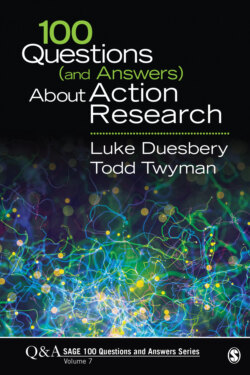Читать книгу 100 Questions (and Answers) About Action Research - Luke Duesbery - Страница 23
Question 13 How Does Action Research Fit in Education?
ОглавлениеIn 1961, a Brazilian educator and philosopher named Paulo Freire led an action research project in which hundreds of sugarcane workers learned to read and write in just a few months. The Brazilian government recognized the potential of the approach and created a system of cultural circles to replicate his approach. These cultural circles brought together elements of literacy with social and political activism.
Action research fits naturally with the field of education. Loosely defined, the field of education encompasses school teachers, school administrators, and the students they serve. All participants can be action researchers. Let’s explore an example from the field of education.
A New Third-Grade Teacher. Fatima is a veteran elementary school teacher. This year, she has been asked to move from her fourth-grade class to teach in the third grade. She noticed when she was a fourth-grade teacher that students would arrive to her class at the beginning of the year not knowing their multiplication tables. Typically, by fourth grade, students are expected to have memorized their times tables up to 12×12. This is necessary because in fourth grade, deeper mathematical concepts are explored that require mastery of those facts. Now that Fatima is a third-grade teacher, she has decided to tackle the problem head-on.
She did a quick Web search of how to teach multiplication facts and saw a variety of approaches. She decided that using flash cards seemed to make the most sense to her. They are quick to administer, take little teacher effort, and progress is easy to track. She began with a lesson in which students made their own flash card sets. Each set would have all multiplication facts with a question on one side and answer on the other. She tested all students with a random set of questions drawn from the multiplication facts before starting the intervention, so she had a baseline. She decided 30 questions on the pretest was enough to find out how much they knew. The test results confirmed that most students had not mastered the facts yet. The average score on the pretest was 22% correct.
Fatima set up a schedule of when each set of facts would be learned. One week the students would practice with their threes, the next their fours, and so on. Every day during the week, first thing in the morning, students would pair up to teach each other with the flashcards for 15 minutes. This is enough time for students to be exposed to each weeks 12 flash cards 10 times. Each week, there would be a test on Friday encompassing all that was learned during that week, and in previous weeks. The tests were cumulative in nature. At the end of 12 weeks, Fatima administered a posttest that was identical to the pretest, so she could see if there was a difference. You’ll remember the average score on that pretest was 22%. She was pleased to learn the average score on the same test 12 weeks later was 93%. She decided the intervention worked, and she would do it again in subsequent years. She also decided she might improve the project if she looked at differences between boys and girls in the next year. She suspected some of the boys might not respond to flashcards as well as the girls. But that would be next year’s project.
More questions? See questions 14, 15, and 16.
